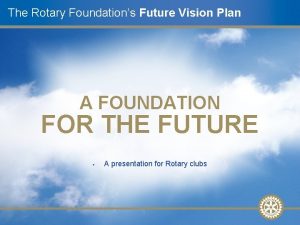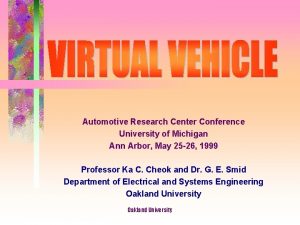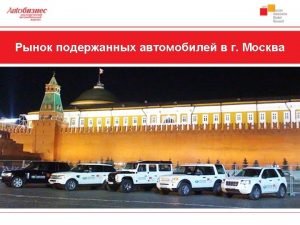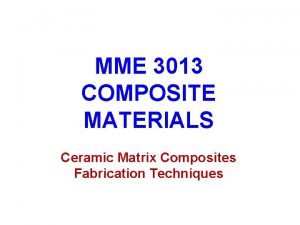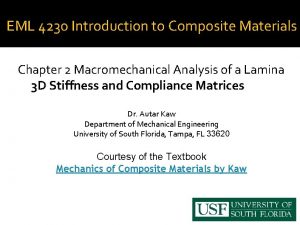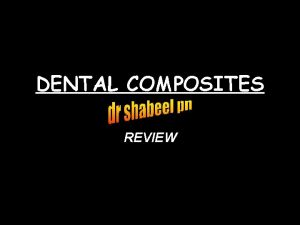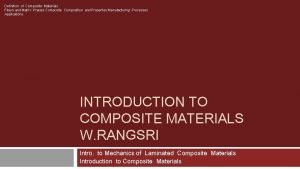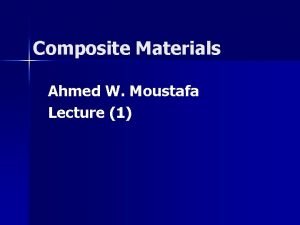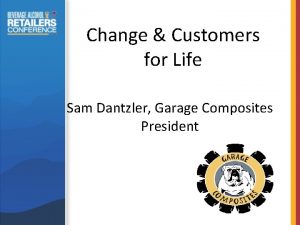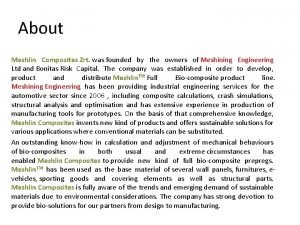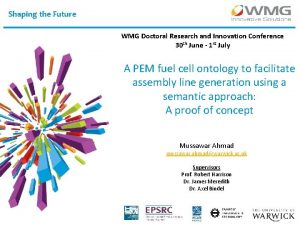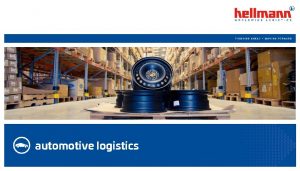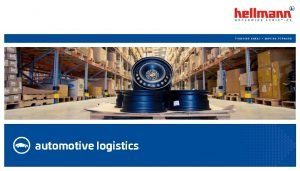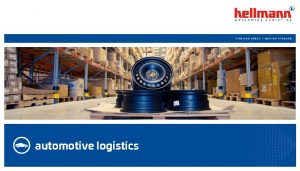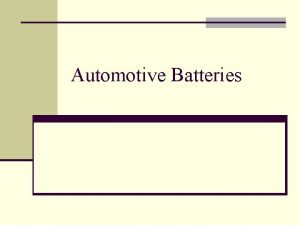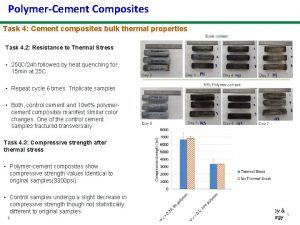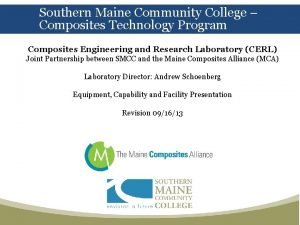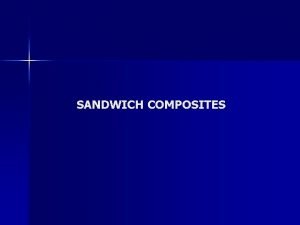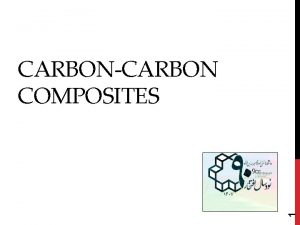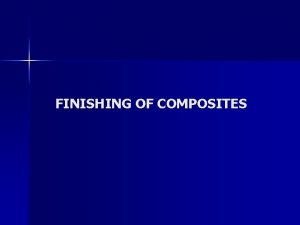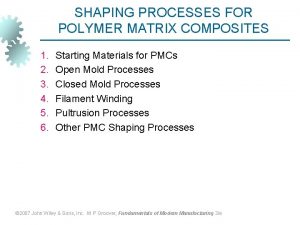Shaping the Future Automotive Composites Research at WMG













- Slides: 13

Shaping the Future Automotive Composites Research at WMG Helena Simmonds Cenex - LCV 2015 10 th September 2015

WMG Professor Lord Bhattacharyya Founder and Chairman of WMG 2 • An academic department within the science faculty of a leading UK university • Established in 1980 to facilitate technology transfer and knowledge creation for Industry • Over 800 people (university and industry) working in 6 buildings (with funding for further new buildings) • Training over 2, 500 individuals in the UK and abroad (covering Engineering Business Management to Manufacturing Engineering - school to post experience) • Co-located with Tata Steel, Jaguar Land Rover, Tata Motors European Technical Centre & Advanced Propulsion Centre

Structural Composites at WMG Processing: – Formability/drape – Pre-preg compression moulding – CF-SMC – Rapid stamp-forming of aligned fibre thermoplastics – HP-RTM & compression RTM, in-situ polymerisation – Automation Joining: – Volume-ready joining techniques – Pre-treatments – Automation Performance: – Stiffness/strength & crash energy management – Durability/fatigue – Provision of key data for performance simulations, enabling vehicle design 3 Professor Kendall Structural Composites Group

ACRC Capabilities - Processing 1. 2 m conveyorised bed x 1. 8 m wide 1. 4 m/s max cutting speed Stationary, roller, vibrating and ultrasonic cutting knives • • • 4 Engel v-Duo 1700 tonne & Hennecke Streamline HP-RTM 2 -D Ply Assembly Zund CNC Cutting Table • • • Picking, assembling, joining Up to 8 layers can be stored 4 -axis robot used to pick and place individual layers • • Compression Moulding press HP-RTM Press • 3+1 (Resin/Polyol)/Hardener/Isocyanate + release agent • 60 litre day tank capacity (x 3) 2. 2 x 1. 8 m usable platen area Sliding lower table

Materials Characterisation Mechanical Testing • 250 k. N Tensile and Compression System (shown) • 100 k. N Tensile and Compression System • Temperature Chamber -60°C to +250°C • Uniaxial, Bi-axial and Video Extensometers • 12 k. J Instrumented Drop Tower (shown) • Very High Strain-Rate Testing Machine • ± 25 k. N Fatigue Test System Analytical techniques • Digital Image Correlation • Scanning Electron Microscope • CT Scanning 5 Thermal Analysis • Dynamic Mechanical Analysis • High Pressure Differential Scanning Calorimetry (HP-DSC)

Modelling and Simulation Business need § Necessary to improve knowledge of the manufacturing processes. § Required to support process development. § Required to support virtual design methodology. Benefits § Help achieve right-first-time designs § Reduce component development time. § Reduce the amount of experimental development required. Applications § Dry and prepreg preforming. § Prepreg compression moulding, SMC compression moulding, HP-RTM. § Thermoplastic rapid stamping Characterisation 6 Predict Raw material Forming Validation

Engel Press & Tool di-electric sensor pressure sensors thermocouples Plaque Mould Engel v-Duo 1700 tonne • • • 2. 2 m x 1. 8 m useable platen area, lower sliding platen Active parallelism in compression 5 -stage speed & pressure control 800 mm/s closing, 580 mm/s opening All press functions instrumented • • • heat flux sensor 7 • 550 x 550 mm, 1 -4 mm cavity with shear edge & auto vacuum control In-cavity sensors • pressure, temperature, di-electric In-mould sensors • temperature, heat flux Processing flexibility • PCM, SMC, HP-RTM, HP-CRTM

Carbon SMC Compression Moulding Sheet Moulded Compounds (SMC) comprise discontinuous fibres 25 -50 mm length (either glass or carbon) in a thermoset resin base compound. • • 8 High Volume Manufacturing method Flow of material allows parts with complex geometry to be manufactured Low wastage Further improvements to process time by automating cutting, charge heating and charge placement

Cavity Thermocouple 1 As the mould fills, the cool material reaches the cavity thermocouple near the edge of the tool. 2 The material absorbs heat of the tool increasing temperature at thermocouple. 3 Local exothermic reaction at thermocouple gives indication of the cure. 9

Parallelism Control 4 As tool meets the material there is imbalance in the parallelism of the press. 5 As material flows the press adjusts the clamp force at tiebars to produce “flat” part. 6 As resin cures the press continues to adjust to maintain a flat plaque. 10

Cavity Pressure 7 Tool meets material, there is an increase in pressure as flow is initiated. 8 As the mould fills, the pressure at the sensors plateau. 9 The material begins to cure - an exothermic reaction which causes a local increase in pressure. Charge Placement 11

Dielectric Monitoring Glass SMC material § § § Gel Time: 38. 8 s Gel Value: 913. 5 Optimum Cure: 105. 4 s Moulding Condition: Temperature: 150 °C 12 Glass SMC

Thanks for Listening Helena Simmonds Lead Engineer WMG, University of Warwick h. c. c. simmonds@warwick. ac. uk 02476 573264 13
 Future perfect and future continuous exercises
Future perfect and future continuous exercises Future perfect future continuous future perfect continuous
Future perfect future continuous future perfect continuous মাইক্রোক্রেডিট
মাইক্রোক্রেডিট China automotive technology & research center
China automotive technology & research center University of michigan automotive research center
University of michigan automotive research center Russian automotive market research
Russian automotive market research Ceramic matrix composites definition
Ceramic matrix composites definition Isotropic material stiffness matrix
Isotropic material stiffness matrix Components and composites ofsted
Components and composites ofsted C factor
C factor Phases of composite materials
Phases of composite materials Ceramic matrix composites definition
Ceramic matrix composites definition Garage composites
Garage composites Mom zrt
Mom zrt


